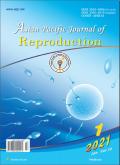Proposed age-stratified reference intervals of FSH derived from normozoospermic men
IF 0.6
Q4 REPRODUCTIVE BIOLOGY
引用次数: 2
Abstract
Objective: To demonstrate that serum follicle-stimulating hormone (FSH) in men rises with age, and to explore FSH reference intervals of age-related partitioning. Methods: Men aged 20-50 years (n=1 190) underwent semen analysis according to World Health Organization (2010) methods. Serum was frozen prior to measurement of FSH by using the Siemens ADVIA Centaur® XP immunoassay system. FSH central 95% intervals after logarithmic transformation based on age were derived from 1 037 normozoospermic men. These were then applied to oligozoospermic and azoospermic men. Men producing azoospermic semen samples were further classified as having non-obstructive azoospermia by clinical diagnostic criteria, including genetic analysis and surgical exploration. Results: Serum FSH in normozoospermic men increased with age (P<0.05), and reference intervals were determined with 10-year brackets: 21-30 years [(1.0-8.2) IU/L], 31-40 years [(1.4-9.5) IU/L], 41-50 years [(1.9-12.0) IU/L]. The proportion of oligozoospermic men with normal FSH concentrations was less than the normozoospermic men, which in turn was lower among azoospermic men (both P<0.01). The azoospermic men were further broken down according to the nature of the azoospermia as either obstructive or non-obstructive azoospermia, and 86.4% (38/44) men with non-obstructive azoospermia had elevated serum FSH concentrations whereas only 6.7% (1/15) men with obstructive azoospermia had high FSH levels, and this was significantly different (P<0.01). Conclusions: FSH concentrations increase in men between 20-50 years, and clinical interpretation of serum FSH results in men must be made by using age-based reference intervals.建议从正常精子男性中提取卵泡刺激素的年龄分层参考区间
目的:证明男性血清卵泡刺激素(FSH)随年龄增长而升高,并探讨年龄分配的FSH参考区间。方法:根据世界卫生组织(2010)的方法,对20-50岁(n=1190)的男性进行精液分析。在使用西门子ADVIA Centaur®XP免疫测定系统测量FSH之前,对血清进行冷冻。根据年龄对数转换后的FSH中心95%间期来自1037名精子正常的男性。然后将其应用于少精症和无精症男性。根据临床诊断标准,包括基因分析和手术探查,生产无精子症精液样本的男性被进一步归类为非梗阻性无精子病。结果:正常精子男性血清FSH随年龄增长而升高(P<0.05),10年内为21-30岁[(1.0-8.2)IU/L],31-40岁[(1.4-9.5)IU/L]41-50岁[(1.9-12.0)IU/L]。FSH浓度正常的少精男性比例低于少精男性,而少精男性在无精子症男性中的比例更低(均P<0.01),86.4%(38/44)的非梗阻性无精子症患者血清FSH水平升高,而只有6.7%(1/15)的梗阻性无精症患者血清中FSH水平较高,这一差异有统计学意义(P<0.01)。
本文章由计算机程序翻译,如有差异,请以英文原文为准。
求助全文
约1分钟内获得全文
求助全文
来源期刊

Asian Pacific Journal of Reproduction
Veterinary-Veterinary (all)
CiteScore
1.70
自引率
0.00%
发文量
588
审稿时长
9 weeks
期刊介绍:
The journal will cover technical and clinical studies related to health, ethical and social issues in field of Gynecology and Obstetrics. Articles with clinical interest and implications will be given preference.
 求助内容:
求助内容: 应助结果提醒方式:
应助结果提醒方式:


